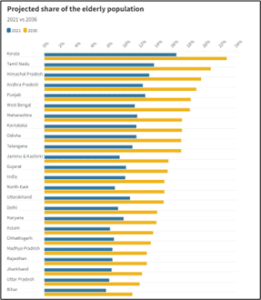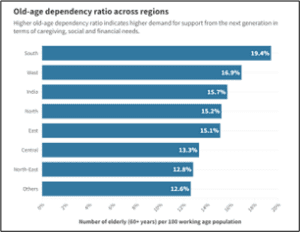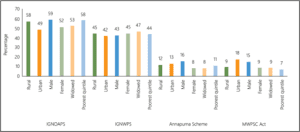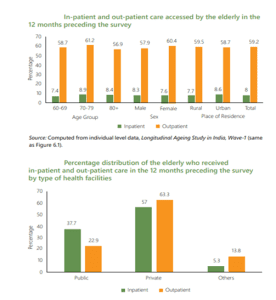THE CONTEXT: The United Nations Population Fund (UNFPA), both globally and in India, focuses on population ageing as part of its strategic plan for emerging population concerns. The recently released UN report highlights the rapid growth of the elderly population in India since 2010, while the number of individuals below 15 has declined. This article comprehensively analyses the report and other related issues of the elderly from the UPSC perspective.
ABOUT THE REPORT
The report released in September 2023, used data from the 2011 Census, the 2017-18 Longitudinal Ageing Survey in India (LASI) conducted by the Health Ministry, population projections of the Government of India and the World Population Projection 2022 report, among other sources. Though the pace of ageing in India is moderate, with the proportion of the aged increasing to 20 percent by 2050, it highlights various key indicators of demographic variations among aging population in India and suggest measures to provide a healthy and dignified life to elderly.
KEY HIGHLIGHTS OF THE REPORT
PROJECTION OF ELDERLY POPULATION
- The decadal growth rate of the elderly population of India currently estimated to be at 41%.
- With this rate, the percentage of elderly population in the country projected to double to over 20% of total population by 2050.
- By 2046, it is likely that elderly population will have surpassed the population of children (aged 0 to 15 years) in the country.
- The report also projected that the population of people aged 80+ years will grow at a rate of around 279% between 2022 and 2050 with a predominance of widowed and highly dependent very old women.

VULNERABILITIES OF ELDERS
- More than 40% of the elderly in India are in the poorest wealth quintile, with about 18.7% of them living without an income.
- Such levels of poverty may affect their quality of life and healthcare utilisation.
HIGHER LIFE EXPECTANCY OF WOMEN
- Women, on average, had higher life expectancy at the age of 60 and at the 80, when compared to men, which varies across States and Union Territories.
- The sex ratio (females per 1,000 males) among the elderly has been climbing steadily since 1991, with the ratio in the general population stagnating.
GENDERED POVERTY
- Poverty is inherently gendered in old age when older women are more likely to be widowed, living alone, with no income and with fewer assets of their own, and fully dependent on family for support.
- Major challenges facing India’s ageing population are the feminisation and ruralisation.
REGIONAL VARIATIONS
- Most States in the southern region and select northern States such as Himachal Pradesh and Punjab reported a higher share of the elderly population than the national average in 2021, a gap that is expected to widen by 2036.

OLD AGE DEPENDENCY
- In the southern region, the old-age dependency ratio (elderly people per 100 people between 15 and 59 years) was higher than the national average at around 20 as is true of western India at 17.
- Overall, Union Territories (13) and the north-eastern region (13) reflected lower old age dependency ratios.

LOW AWARENESS LEVEL
- A little more than half of the elderly (55%) are aware of the old-age pension scheme (IGNOAPS); 44% about the widow pension scheme (IGNWPS); and 12% about the Annapurna Scheme.
SIGNIFICANCE OF THE REPORT
By 2050, the share of older persons in India will double to 20.8 percent, with the absolute number reaching 347 million. This rise in the ageing population will have significant implications for health, economy, and society in India. The elderly population in India is expanding rapidly and may surpass the children’s population by mid-century. This makes it imperative for the government to draw broad policy guidelines for better care to the elderly.
INTERNATIONAL POLICY FRAMEWORKS ON AGEING
WORLD ASSEMBLY ON AGEING
- The First World Assembly on Ageing was held in 1982, which established the International Plan of Action on Ageing. This plan emphasized the rights of older persons, including independence, participation in society, access to care, dignity, and self-fulfilment.
- The Second World Assembly on Ageing took place in Madrid in 2002. This assembly aimed to address the global ageing agenda and its impact on development. The main outcome documents from this assembly were the Political Declaration and the Madrid International Plan of Action on Ageing (MIPAA), 2002.
- The UN Resolution (75/131) expressed concern about the world not being sufficiently prepared to respond to the rights and needs of older people. It emphasized the need for a whole-of-society approach to address the challenges of ageing.
UNITED NATIONS DECADE OF HEALTHY AGEING
- The World Health Organization (WHO) initiated the Decade of Healthy Ageing (2020-2030), focusing on four areas: age-friendly environments, combating ageism, enhancing functional ability, and improving long-term care systems. The goal is to ensure older people can live a life commensurate with their basic rights, fundamental freedoms, and human dignity.
GOVERNMENT RESPONSE FOR THE CARE OF ELDERLY
The care of the elderly is imperative for governments because they represent a significant portion of the population, having contributed to the societal, cultural, and economic foundations of the nation in their prime years. As they age, they face unique vulnerabilities, from health challenges to economic insecurities.
Without state intervention, they might lack access to essential services, leading to increased socio-economic disparities.
In recent years, the Indian government has initiated several measures to enhance the welfare and well-being of the elderly.
- Rashtriya Vayoshri Yojana (RVY): Launched in 2017, this program provides free physical aids and assisted living devices for senior citizens belonging to the Below Poverty Line (BPL) category.
- Pradhan Mantri Vaya Vandana Yojana (PMVVY): Started in 2017, this is a pension scheme tailored for senior citizens, offering a guaranteed rate of return over its tenure.
- Senior Citizens’ Welfare Fund: Established in 2015, this fund channels unclaimed amounts from various financial schemes for the welfare of senior citizens and their promotion of healthcare and social security.
- Atal Vayo Abhyuday Yojana (Formerly National Action Plan for Senior Citizens (NAPSrC): provides a comprehensive action plan for services like health, housing, and welfare to senior citizens, including protection against abuse.
- Livelihood and Skilling Initiatives for Senior Citizens – Senior Able Citizens for Re-Employment in Dignity (SACRED); Action Groups Aimed at Social Reconstruction (AGRASR Groups): Elderly Self-Help groups etc. are other initiatives by the government to aid the elderly in leading a dignified life.
Such initiatives reflect the government’s holistic approach to elderly care, encompassing economic well-being, health, and social security.
CORPORATE SECTOR AND THE WELFARE OF SENIOR CITIZENS
The government has implemented several programs and schemes for senior citizens’ welfare. However, given the increasing numbers of the elderly, the private sector can also play a significant role in addressing their vulnerabilities. Under Schedule VII of the Companies Act, 2013, corporate entities are mandated to spend 2% of their net profits averaged over three preceding financial years for social development.
Ageing issues have been added as a focus area for corporate social responsibility (CSR) spending, which includes initiatives like vocational skills development, livelihood enhancement projects, setting up old age homes, day care centers, and benefits for armed forces veterans and war widows.
HelpAge India, one of the nation’s leading NGOs working for the elderly, partnered with HDFC Ltd. Through this partnership, HDFC funded Mobile Medical Units (MMUs) which provide primary healthcare services to destitute elders in remote areas.
Tata Steel Rural Development Society (TSRDS): This CSR arm of Tata Steel has been active in setting up old age homes in various areas, providing senior citizens with shelter, food, medical care, and recreational activities.
Apollo Hospitals’ “Project Arogya”: Apollo Hospitals, in association with NGOs, has set up clinics that offer geriatric care, covering consultations, diagnostics, and health checks at subsidized rates for the elderly.
These case studies exemplify how the corporate sector, in collaboration with NGOs and on their own, are creating tailor-made solutions for the burgeoning elderly demographic in India, ranging from healthcare to technology solutions.
COMMUNITY BASED ORGANISATIONS AND ELDERLY CARE
Community-Based Organisations (CBOs) play a pivotal role in the welfare of the elderly in India. They act as a bridge between the grassroots level and larger NGOs or governmental organizations. Few notable CBOs and their contributions to the welfare of the elderly in India:
- Agewell Foundation: Founded in 1999, this network of over 1500 NGOs and 6500 volunteers works at the grassroots level across India to address issues faced by the elderly. They focus on health, legal literacy, economic security, and human rights for senior citizens.
- Dignity Foundation: Operating primarily in urban settings, this organization provides a platform for senior citizens to share their concerns. They offer programs ranging from helplines, health workshops, and even a magazine dedicated to the elderly.
- Harmony for Silvers Foundation: Founded by Tina Ambani, this foundation publishes “Harmony”, a magazine dedicated to issues related to senior citizens. They also organize initiatives and programs tailored for the elderly.
- Nightingales Medical Trust: Based in Bangalore, this trust focuses on health and medical services for the elderly. They run memory clinics for dementia and Alzheimer’s patients and offer physiotherapy, geriatric care, and other healthcare services.
- Positive Ageing Foundation: This Delhi-based organization focuses on comprehensive care for the elderly, dealing with health, finance, legal issues, and emotional well-being.
- The Anugraha Foundation: Based in Pune, they focus on holistic development and care of the elderly, especially those suffering from Alzheimer’s and related disorders.
These CBOs, through their dedicated services and programs, play an integral role in enhancing the quality of life for the elderly, advocating for their rights, and ensuring they remain integrated and valued members of society.
REACH AND UTILIZATION OF SOCIAL SECURITY SCHEMES AND HEALTHCARE BY OLDER PERSONS
- Knowledge of Social Security Schemes and Maintenance and Welfare of Parents and Senior Citizens Act (MWPSC), 2007: Only 55% of the elderly are aware of the old-age pension scheme (IGNOAPS), 44% about the widow pension scheme (IGNWPS), and 12% about the Annapurna Scheme. The report presents the percentage of elderly individuals aware of these schemes based on various background characteristics.

- Utilization of Social Security Schemes: Despite awareness, there are gaps in the actual utilization of these schemes. For instance, even among those aware of the schemes, actual utilization is low. This gap could be due to supply system factors, demand system factors, or a combination of both.
- Access to Healthcare Facilities: Healthcare utilization among the elderly varies between in-patient and out-patient care. About 8% of the elderly accessed in-patient care, while 59% accessed out-patient care in the 12 months preceding the survey.
For in-patient care, 37.7% accessed public facilities and 57% accessed private facilities. For out-patient care, 22.9% accessed public facilities, and 63.3% accessed private facilities.

- Health Insurance Coverage: The coverage of health insurance schemes is highest in the age group of 60–69 years (20.4%). Elderly men (19.7%) had a greater share of coverage than elderly women (16.9%). There wasn’t much variance between urban and rural areas regarding health insurance scheme coverage.
The findings three primary factors determining the utilization of various social security schemes for the needy elderly: knowledge/awareness, reach/access, and actual use, according to the report suggest that while awareness is low, there’s also a gap between awareness and use. This makes it imperative for future policies to address the gap by taking required actions to increase awareness among target beneficiaries.
COVID-19 PANDEMIC AND THE ELDERLY
Senior citizens were particularly vulnerable during the pandemic due to their age, health co-morbidities, and economic vulnerabilities. The lengthy lockdowns affected their access to healthcare, ongoing medical treatments, and availability of medicines. Many faced increased fear and anxiety due to isolation, lack of physical activity, and forced loneliness. Many elderly households were pushed below the poverty line during the pandemic, impacting both their lives and livelihoods.
Poverty, lack of social security in old age, poor public health facilities, illiteracy and digital ignorance created additional challenges. Service delivery to those living independently or in institutions such as old age homes was also proving to be difficult, and here, efforts of nongovernmental organization (NGOs) and community-based organizations (CBOs) were invaluable.
While governments are able to plan and implement such programmes, NGOs and CBOs are able to supplement and complement government efforts by reaching the grassroots level, especially in remote areas.
CASE STUDY: ROLE OF HELPAGE INDIA
During the first wave of the pandemic, HelpAge India’s helpline staff, along with volunteers (including student volunteers), called members of senior citizens’ associations to spread awareness about the government’s guidelines. HelpAge India’s pandemic response focused on several areas:
- Food and Nutrition: In collaboration with corporate partners, HelpAge India distributed 150,000 meals to old age homes, day care centers, and urban destitute elderly. This included 70,000 meals in Delhi/NCR and 24,000 in Telangana. The meals and hygiene kits were initially distributed in urban slums, semi-rural areas, and old age homes.
- Communication: The organization emphasized spreading awareness about COVID-19 protocols.
- Medical Health Units (MHUs): During the lockdowns, MHUs initiated public health awareness campaigns to educate the elderly about the pandemic.
- Vaccination Drive: HelpAge India teams actively participated in the government’s vaccination drive, conducting outreach programs to maximize the number of older persons getting vaccinated. They also provided communication material to address vaccine hesitancy and inform about post-vaccination symptoms.
- Livelihoods: To support the decreased income of Elder Self-Help Groups (ESHGs) during the pandemic, a corporate-supported program was initiated that provided ₹5,000–₹5,500 as a direct benefit transfer.
Support and Collaboration: HelpAge India’s decentralized procurement procedure helped reduce response time. They partnered with mobile health units (MHUs) and local partners (NGOs/CBOs and senior citizens associations) to ensure the last mile distribution and delivery of services. Elder self-help groups (ESHGs) were formed in partnership with other voluntary organizations and community members.
Helpline Services: During the second wave, HelpAge India’s helpline provided guidance on legal aspects, counselling, moral support, and facilitated direct interventions. In Delhi, the helpline assisted 60% of older persons in securing hospital beds and followed up with them for treatment. The helpline team also coordinated with local police and medical units for blood plasma, oxygen, and assisted the local administration in other areas.
The pandemic highlighted the increased vulnerability of older individuals, especially those with non-communicable diseases. The interruption in the primary healthcare system particularly affected the elderly. The pandemic underscored the need for better mental health and counselling services, along with curative care.
The Way Forward according to UNFPA:
1. Role of the Government:
- Financial and technical support: For any pan-India development initiative (including elder care), the government need to come up with a clear and cogent policy-based technical, financial and administrative support backed by effective technology-led communication strategy.
- Enhancing collaboration among stakeholders: the government needs to focus on systematic coordination, convergence and collaboration across key stakeholders to avoid duplication of effort, operations at cross-purposes and bureaucratic hold-ups.
Departments within the government need to converge their efforts to ensure that their respective programmes are elderly friendly and delivered in a holistic fashion. For example, programmes of the Ministry of Health and Family Welfare should prioritize the training of service providers and supervisors on geriatric care.
- The government, private sector and relevant institutions can work together to encourage research and knowledge building on the implications of prevailing and emerging social, political, economic, technological, market and business, financial, health and institutional processes and safety nets on ageing including services and products for the elderly.
- District Development Officers in close collaboration with PRIs must develop better convergence of development initiatives in villages aimed at improving lives and living standards of elderly taking a comprehensive view rather than individual projects.
2. Others:
- Apart from government sources, there is significant scope for mobilizing Corporate Social Responsibility (CSR) funds for this purpose as elder care.
- Community Based Organisations (CBOs) can also be further promoted to enable regular interface between project beneficiaries and managers at central and state levels so that inputs from the community can enrich project design, implementation and create opportunities for mid-course correction for better outcomes and improved outreach.
- Active PRI involvement is essential for community transformation aimed at building a supportive environment for senior citizens. The innovative interventions related to the elderly by PRIs such as Kudumbashree, Asraya and Palliative Care in Kerala, which can be replicated in other states as well.
- Indian culture stands on the concept of filial piety, where caring for the elderly is considered a duty of the younger generation. Intergenerational solidarity and the relationship between generations need to be nurtured for ensuring the wellbeing of the elderly.
THE CONCLUSION: The impending rise in the old age population in India in the coming decades will bring a demographic shift which can have significant implications for the health sector, economy, and society. The UNFPA Report 2023 serves as a reference document for stakeholders to develop programs and initiatives that cater to the needs of the elderly. Caring for the elderly not only upholds their rights to a dignified life but also promotes societal values of respect, gratitude, and inter-generational cohesion. Furthermore, their wisdom, experiences, and skills are invaluable assets, which can be harnessed for the greater societal good.
Mains Practice Questions:
Q.1 The UNFPA Report 2023 highlights the vulnerabilities faced by the elderly in India. In this context discuss the government initiatives for the aging population in India.
Q.2 Discuss the reasons for the ‘feminisation’ and ‘ruralisation’ of older population in India.
Spread the Word
